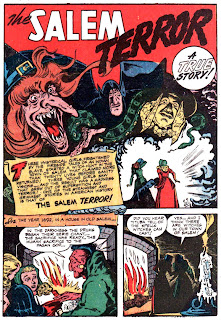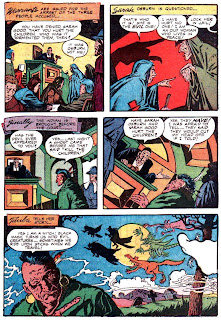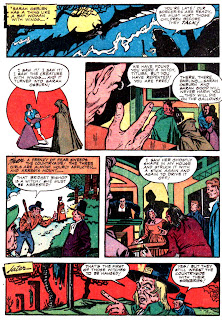
Number 920
Witches of Salem
The Salem witch trials are one of the more bizarre chapters in American history. My earliest American ancestor came to Massachusetts in the 1620s, and for all I know could have been caught up in the superstitious madness. I have a lifelong fascination with the Salem witches. "The Salem Terror" is a concise "true"* story published in Wanted Comics #13, 1948. It's drawn in a garish and sensational style by Maurice del Bourgo, who signed his name "del" at the bottom of the splash panel.
*As I've said before in this blog, "true" is a floating concept for stories in comic books, right alongside ads for "guaranteed" weight loss nostrums and useless cures for pimples or bed wetting.








That was a new twist, Titiba as an American Indian! (She was, of course, a West Indian). I did like the artwork on this, especially that wonderful splash panel.
ReplyDeleteThe 1620s!
ReplyDeleteWhy you're practically American Royalty, Pappy!
Interestingly, this feature depicts Tituba as a Native American, while others've depicted her as African.
I'm almost certain she wasn't either 'Indian' or African because her witchcraft beliefs certainly seem inauthentic compared to Native American or African derived systems.
In comparison with the European systems Italian historian Carlo Ginzburg found compelling intermittent evidence for, going right back into prehistory, though, Tituba could almost've been quoting verbatim from the ancient European wide trial records Ginzburg made much use of.
Personally I'm not even sure she was necessarily black - mixed race, MAYBE - because a lot of people nowadays don't realise there were a number of ancient derived customs, usually involving debt, whereby white people could be openly kept as slaves too, something that unspecialised historians're quite coy in admitting to, right up to the present day.
Even in Britain, every so often, Eastern European women get liberated from prostitutional imprisonment by Russian mafia - and yet the UN'd have us celebrate the end of slavery!
Another great post! And another great artist I've never seen before. "Sensational" is the word.
ReplyDeleteLove the NRA bit in the sidebar. I'm with you, brother.
American royalty, eh? According to the genealogy done by my late granny in the 1960s my earliest American ancestor was English, and showed up on the record as being married in 1628 in Massachusetts. I visualize him looking like Poopdeck Pappy, a one-eyed seadog who jumped ship.
ReplyDeleteAldiboronti, The scripter might have written "West Indian" in a description of Titiba, but the artist may not have known the difference between a Native American and West Indian.
I stand by my definition of the word "true" as used in comic books.
I am a person considered offensive to society, nineteenth century tell a thousand views, I visited your blog and I love, a hug from Reus Catalonia and many thanks for visiting my blog, you are a very brave person.
ReplyDeleteAs a point of historical accuracy, the real Tituba was consistently described in the primary sources by those who actually knew her as an "Indian," and in some cases, a "Spanish Indian," People in the 18th century knew the difference between someone who was "Indian" and someone who was, in their term, "Negroe." Even thought Tituba is known to have been brought from Barbados, where many slaves of African origin in the 19th century, Native Americans were also a large part of the slave trade in the 17th century. See Elaine Breslaw's book, "Tituba, Reluctant Witch of Salem" if you're interested in reading more.
ReplyDelete